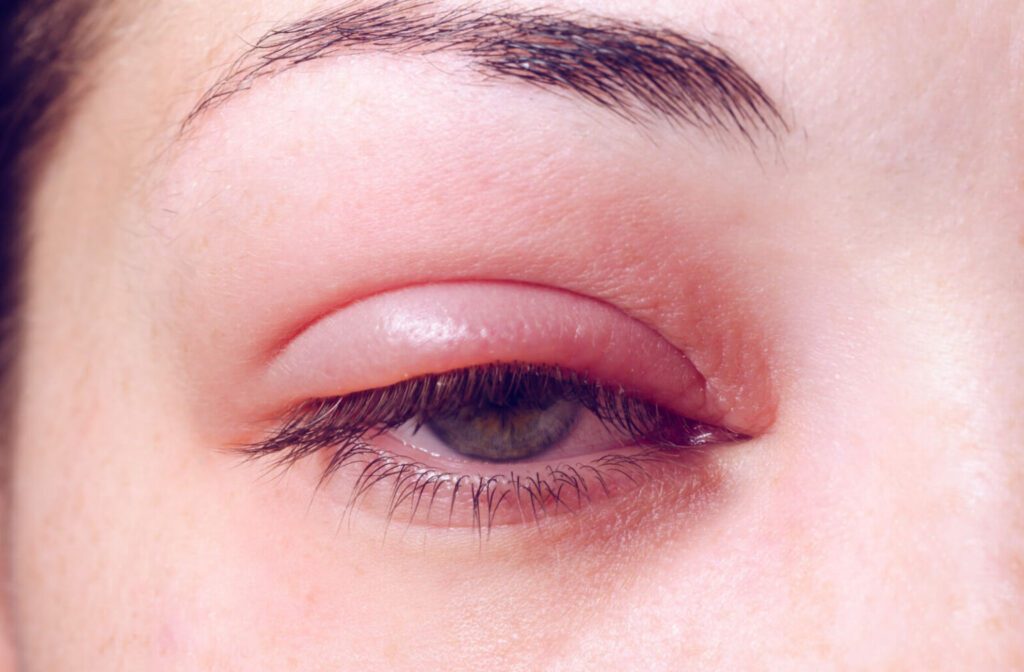Table of Contents

Introduction
You don’t have to suffer from dry eyes. Dry eye disease impacts millions of Americans every year, and it can be more than just a minor inconvenience. Living with untreated dry eyes can make it difficult to perform everyday tasks and even cause damage to the surface of your eye.
If you have already discussed your dry eye disease with your eye doctor, they may have discussed TearCare or LipiFlow treatments with you. Both treatments use heat therapy to relieve dry eye symptoms caused by meibomian gland dysfunction. The TearCare system can also treat eyelid inflammation, called blepharitis.
TearCare and LipiFlow are both in-clinic treatments that we offer at Golden Vision Optometry. Your eye doctor will work with you to determine if you are a candidate and which treatment will work best for you. To book a consultation, click the button at the top of the page.
What is Meibomian Gland Dysfunction?
Meibomian gland dysfunction (MGD) is a condition that causes your meibomian glands to become clogged, which can interfere with tear production and cause dry eyes.
Meibomian glands are located along the edge of your eyelids, near your eyelashes, and create oils (called meibum) that play an important role in healthy tear production. The oil produced by your meibomian glands creates the oily outer layer of your tears that prevents them from drying too quickly. Blocked meibomian glands cannot produce sufficient meibum, causing you to experience evaporative dry eye.
For individuals suffering from MGD, standard dry eye treatments like over-the-counter eye drops will only provide temporary relief as they do not treat the underlying cause of the issue. Treating mild cases of MGD with a warm compress may be enough to help clear meibomian gland blockages. However, individuals experiencing more advanced cases of MGD may benefit from other types of thermal therapy to promote healthy tear production, which is where TearCare and LipiFlow come in.
TearCare Treatment
The TearCare system is a blink-assisted device that provides localized heat therapy to treat dry eye disease caused by MGD.
How It Works
Benefits
Treatment can be administered while your eyes are open, which may make treatment more comfortable for some patients. You also do not need to use numbing eye drops for this treatment.
In addition to treating MGD, the TearCare system can also treat blepharitis, which can contribute to dry eye symptoms.
Limitations
The TearCare system was designed to be used in conjunction with manual expressions of the meibomian glands. Because the device administers heat alone, additional treatments to massage the meibomian glands will be necessary to get optimal results.
LipiFlow Treatment
LipiFlow is a thermal pulsation system that simultaneously applies heat and gently massages your eyelids to eliminate blockages caused by MGD.
How It Works
Before treatment, your eye doctor will administer numbing eye drops to reduce discomfort during the procedure. The LipiFlow system uses thermal pulsation technology to apply a combination of heat and pressure messages to the inner eyelids, where your meibomian glands are located. Treatment takes 12 minutes and is administered through dome-shaped, single-use system activators placed on your eyelids.
The thermal therapy plus the pressure massages liquefy and clear blockages in the meibomian glands.
Benefits
The LipiFlow system simultaneously administers dual heat and pressure treatment, meaning that, unlike TearCare, patients do not require additional meibomian gland expressions to see optimal results.
According to one study, the benefits from a single 12-minute LipiFlow session can last up to three years.
Limitations

How Do TearCare & LipiFlow Compare?
Both TearCare and LipiFlow treatments aim to provide long-term relief from dry eye disease caused by MGD, but does one work better than the other? In a study, TearCare and LipiFlow proved to be equally effective as one another one month after a single treatment.
The Similarities
- Treatment time:
- TearCare: 15 minutes
- LipiFlow: 12 minutes
- Non-invasive: Both treatments are non-invasive and are administered using sterile, one-use applicators placed on the eyelids.
- Heat therapy: Both TearCare and LipiFlow use targeted heat therapy to melt blockages in the meibomian glands.
- Results: TearCare and LipiFlow have been shown to be equally as effective in treating MGD one month after treatment.
The Differences
- Comfort:
- TearCare: The system allows you to keep your eyes open and blink naturally during treatment. No numbing eye drops are needed.
- LipiFlow: Patients cannot open their eyes during treatment and require numbing eye drops to prevent potential discomfort.
- Pressure treatment:
- TearCare: Treatment should be done in conjunction with manual meibomian gland expressions, as the treatment only administers heat to the eyelids.
- LipiFlow: Provides a combination of thermal and pressure massage treatment. Additional manual expressions are not necessary.
Both TearCare and LipiFlow are effective treatment options for individuals with MGD. Deciding which option is best for you will require getting to know your unique visual needs.
Finding What Works Best for You
Both TearCare and LipiFlow have their benefits and potential drawbacks, so it is best to consult with your eye care professional to determine which treatment is the best option for you. At Golden Vision Optometry, we offer both options at our clinics and would be happy to discuss your dry eye treatment options at a consultation appointment.

